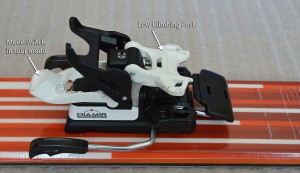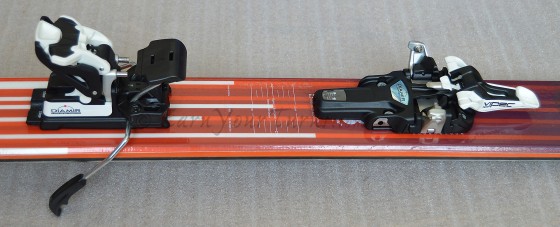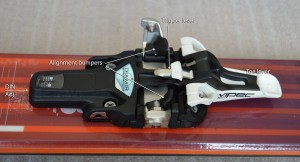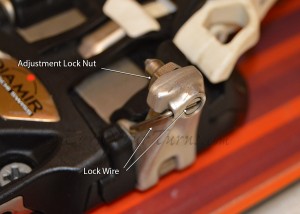Whether good or bad, first impressions last and last and last. In the long run, if you can last long enough, weak first impressions can be buried in the glory of redemption. It will take more time to prove but I think it’s time to acknowledge that Fritschi’s Vipec really rocks they way they hoped it would, but didn’t quite, three years ago. To make sure you notice, Vipec’s back — in black.
It was 2012 when Fritschi showed off the Vipec 12, the first tech binding to feature lateral release at the toe, the sort of safety release alpine skiers were familiar with. Last year the Vipec was certified to ISO 13992 by TUV, meaning it releases consistently under test conditions, and thus by extension reliably in the field.
That the Vipec would pass certification was something Fritschi was confident of from the get go. However, confidence in what they had up their sleeve was suspect thanks to a prototype exploding on camera for the internet to laugh at. That wasn’t the only flaw in the ointment the first year. The toe pins required adjusting, and then were prone to falling out in the field. Though less likely, the heel unit could fill with snow preventing mode changing. But the worst part was they were a fiddle-fest in a foreign language no one had ever flustered with before.
Thankfully, those days are over!
Clicking In
To make getting in to the binding easy Fritschi did a number of things. First, for 2015, they added plastic guides on the sides of the pin arms. This helped, but more was needed. In the 2016 black version Fritschi changed the internal spring mechanism that triggers the pins to close and added a white tab on the trigger lever to help with lining up the front of the boot so the inserts are aligned with the pins. With these changes to the toe, getting in is much easier. In my experience, I clicked in first try 4 out 5 times, and that was on day one. Two years ago, it was more like 1 out of 4. When I did miss, it was inevitably because my boot was tilted side-to-side. To help keep it flat I find it best to rest the heel of the boot on the brake pad and then lower the toe so it lines up in front with the white tab on the trigger lever. Tap lightly at the toe and – wham! – the pins clamp down fast and tight. As with any 2-pin toe, there will still be times it may frustrate you. Such is the fate of all dynafiddlers, no matter what brand you’re using.Downhill Mode

The Vipec’s heel has always offered the ability to switch modes without exiting the binding. The black version is sealed to prevent snow creeping in and preventing mode changing.
The real beauty of Vipec’s toe is that the return to center force at the toe remains constant even as the displacement increases, until at 13.1mm it releases. With most 2-pin designs, the lateral release comes at the heel. This isn’t right or wrong, but as the heel moves, traditional pins open up and the more they open, the clamping force is progressively reduced making release more likely. That’s why most tech bindings have a reputation for premature release, and why the Vipec is more likely to deliver a release that, as an alpine skier, you’ll be satisfied with.
Besides the lateral elasticity, the heel is designed to absorb compressive forces that can occur when the ski flexes. The prevents the binding releasing because the boot is forced forward, potentially binding between toe and heel. Not so with Vipec.
In my experience it didn’t matter whether I was rattling down choppy hardpack or bouncing through the bumps, Vipec held fast. Of course, this was expected; after all, once you fix the heel, you fix the problem, right?
Uphill Mode
One of the things that you will inevitably appreciate with Vipec is the ability to switch modes without exiting the binding. To free your heel for walking mobility simply push down on the mode switch lever at the back of the heel. This will cause the heel unit to slide back, releasing the heel of your boot.
With the heel free, you can engage a moderate (7°), or mildly high (13°) climbing post by flipping one, or both forward with a ski pole. It does take a bit of practice to flip the posts forward easily, not because it requires much force, but it does take some precision in locating your pole basket or handle to hook the side of each post as necessary. It’s a whole lot faster than spinning the old volcano post on legacy Dynafit heels.
Typically you will want to also lock out release at the toe for skinning up. Unlike other tech bindings, Vipec doesn’t really lock out release, it increases the retention value when you lift up the toe lever. However, unlike previous versions, Fritschi added extra holding power this time around. You still might release if you’re stomping on an icy traverse, but in that case, it is probably because the boot moved far enough laterally for the pins to trigger the safety release. If you’re stomping that hard, you probably should have installed ski crampons a few steps back. Just sayin’.
Speaking of, ski crampons are available in two widths, 95mm and 120mm. Seems like something in the 110ish width would be a popular size. In any case, ski crampons are not cheap, but when you need ’em, that cost will seem inconsequential.
Even though you can switch from downhill to uphill mode without exiting the binding, the reality is you probably still will to put your climbing skins on. It should be noted, however, it is possible, with practice and good balance, to attach climbing skins with your skis on. Where you will really appreciate the simplicity of changing modes is when you want to quickly free the heel for crossing a long flat zone – too long to skate across and too short to be worth adding skins for – before continuing your descent. With most other AT bindings changing modes requires disembarking from the binding.
Switching back to turn mode is as easy as lifting the mode switch lever back up until it snaps in place.
One of the rare problems with earlier versions of Vipec was the potential for snow to pack inside the heel unit preventing the mode switch from either locking the heel back for touring, or forward for turning. This new black heel addresses that by covering the internal cavity so snow can’t sneak in and restrict the travel range needed to toggle between modes.
Adjustments
Last year Fritschi fixed the problem with the adjustable pin working it’s way loose. This was done by moving the adjustment pin to the right side, and then adding a wire lock to prevent it loosening while touring. In addition they set the pin gap at the factory so it works for 90% of the inserts on the market. Thus, the likelihood of even needing to adjust the pin gap at the toe is reduced.You can determine if you need to adjust the pin gap yourself by performing a simple test. Put your boot in the binding, and push it laterally so the toe is deflected about a quarter inch and then let go. If it snaps back without resistance it needs no adjustment. But if it binds and doesn’t return easily, the pins are probably too tight. If they’re too wide, and you push them to the point where they should release (more than 13mm deflection), they won’t.
Fritschi has a good four-point inspection routine that is worth looking at to make sure your boot will work properly with the black Vipec.
The ski brakes work well, but still occasionally do not deploy when switching from tour (heel retracted and brakes locked up) to turn mode. This doesn’t affect deployment when you’re skiing downhill, since the boot holds the brake arms retracted, but in tour mode, it is a latch that doesn’t let go reliably when toggling the heel unit back to downhill mode. Where this is an issue is when you take your skis off to remove skins and you set the ski down without the brake deployed. A quick hand smack fixes that, but you need to remember to check it, lest your ski take off when you look away.
Conclusion
You might still hear some negativity about Vipec, but those comments are almost certainly based on prior versions. The Black Vipec is ready to rock your world. For those who are coming directly from the alpine resort world it has lateral release at the toe, built around 25mm (± 13mm) of elasticity to keep from releasing prematurely. That means you can ski hard without being concerned about the diminutive size of the binding, or it’s plastic frame. It’s a lightweight, 2-pin binding made to make alpine touring fun and safe, with the convenience of being able to switch modes without taking your skis off, something you’ll quickly become spoiled by.
Fritschi
Vipec Black
MSRP: $600
Weight/binding: 1 lb., 3 oz. (545 g)
Brakes widths available: 95mm, 108mm, 120mm
Triaxion Crampons
MSRP: $110
Crampons widths available: 95mm, 120mm
© 2016
Related Posts
Fritschi’s Fixes for Vipec 2014
Devilish details of Vipec (2013)
First Look: Fritschi’s Vipec (2013)
Editor’s Note: Intro paragraphs down to Clicking In were revised 31oct16.




3 comments
Helpful review thanks. The arrival of spring in New Zealand is always confirmed by the end of the long winter silence on EarnYourTurns. I have the 2015 version of the Vipec. Was enjoying them Sunday after a late spring storm brought brief powder joy to these parts.
Great binding in many respects, but I have found the alignment bumpers of no use in getting into the binding. I have some days when the fiddle is crazy stupidly frustrating. I can dispute your claim that all pin bindings have this issue to some degree. I just wave my boot in the general direction of the Marker Kingpins and they seem to magically levitate to attach themselves to my boots, first time every time. Just uncanny how simple and easy it is in comparison. I am surprised that the white tab on the trigger lever of the Vipec could make so much positive difference, but good to hear!
Everything else about the Vipec is superb, and you touch on all those points in this review. The crampons are a particular joy to use after years of telemark make-do options. The spring-action attachment, without necessarily removing the boot from the binding, is genius.
One issue someone may be able to help with. I lost the locking nut off the pin of one of my Vipec toepieces. I have had a few days skiing without it, there is no risk of the pin falling out, as the locking pin takes care of that. But I am worried that the leverage the boot exerts on the pin with the missing lock nut will eventually cause fatigue and failure. Here at the end of the global supply chain, trying to order a part like that is an exercise in futility. I was given the replacement pin and nut that Fritschi had issued for pin issues, but the 2015 toe piece is an entirely different size and the replacement pin doesn’t fit. Does anyone happen to know the gauge of the thread on the pin/nut on the 2015 model? It is NOT the M5 which is mentioned in the service notice that is circulating. I haven’t had any joy finding a matching nut at the fastener suppliers yet.
Agree, the black bumpers don’t do a lot, but the white tab (and modified leaf spring action inside) DO make a difference. The Kingpin is purty darn easy but it doesn’t snap closed as fast as Ion or Vipec. However, if it lines up first time everytime who needs pins that snap tight fast. Easy is as easy does.
Seems like this would be a great candidate for use in a tele tech toe build, with the return to center helping with retention. Unfortunately, it looks like the area behind the pins extends too long to make this work. At least AT skiers will benefit from this feature.